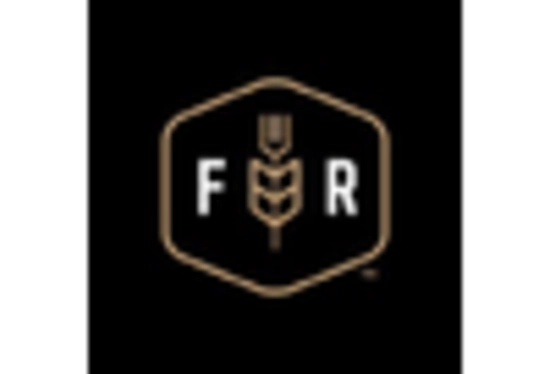The Vegan Protein Food Market is currently characterized by a dynamic competitive landscape, driven by increasing consumer demand for plant-based alternatives and heightened awareness of health and sustainability. Major players such as Beyond Meat (US), Impossible Foods (US), and Oatly (SE) are strategically positioned to capitalize on these trends. Beyond Meat (US) focuses on innovation in product development, recently launching a new line of plant-based sausages that cater to diverse culinary preferences. Meanwhile, Impossible Foods (US) emphasizes partnerships with major fast-food chains to expand its market reach, thereby enhancing brand visibility and consumer accessibility. Oatly (SE) has adopted a regional expansion strategy, targeting emerging markets in Asia, which reflects a broader trend of global outreach among key players in the sector.
The business tactics employed by these companies include localizing manufacturing to reduce costs and optimize supply chains, which is particularly crucial in a market that is moderately fragmented. This fragmentation allows for a variety of niche players to thrive alongside larger corporations, creating a competitive structure where innovation and brand loyalty play pivotal roles. The collective influence of these key players shapes market dynamics, as they continuously adapt to consumer preferences and regulatory changes.
In August 2025, Beyond Meat (US) announced a partnership with a leading grocery chain to introduce a new line of ready-to-eat meals featuring its plant-based proteins. This strategic move not only enhances product accessibility but also aligns with the growing trend of convenience in food consumption. By tapping into the ready-to-eat segment, Beyond Meat (US) positions itself to attract a broader consumer base, particularly among busy professionals and families seeking healthier meal options.
In September 2025, Impossible Foods (US) launched a new marketing campaign aimed at promoting its products as sustainable alternatives to traditional meat. This initiative underscores the company's commitment to environmental responsibility and aims to educate consumers on the benefits of plant-based diets. By leveraging digital platforms and social media, Impossible Foods (US) seeks to engage younger demographics, which are increasingly concerned about sustainability and ethical consumption.
In July 2025, Oatly (SE) expanded its product line to include a new range of vegan protein bars, targeting health-conscious consumers. This diversification strategy not only enhances Oatly's product portfolio but also positions the company to compete more effectively in the growing snack segment. The introduction of these protein bars reflects a broader trend towards health-oriented products, which is becoming increasingly important in consumer decision-making.
As of October 2025, the competitive trends in the Vegan Protein Food Market are heavily influenced by digitalization, sustainability, and the integration of artificial intelligence in product development and marketing strategies. Strategic alliances among companies are becoming more prevalent, as they seek to leverage each other's strengths to enhance market presence. Looking ahead, competitive differentiation is likely to evolve from traditional price-based competition to a focus on innovation, technological advancements, and supply chain reliability, as companies strive to meet the ever-changing demands of consumers.


















Leave a Comment